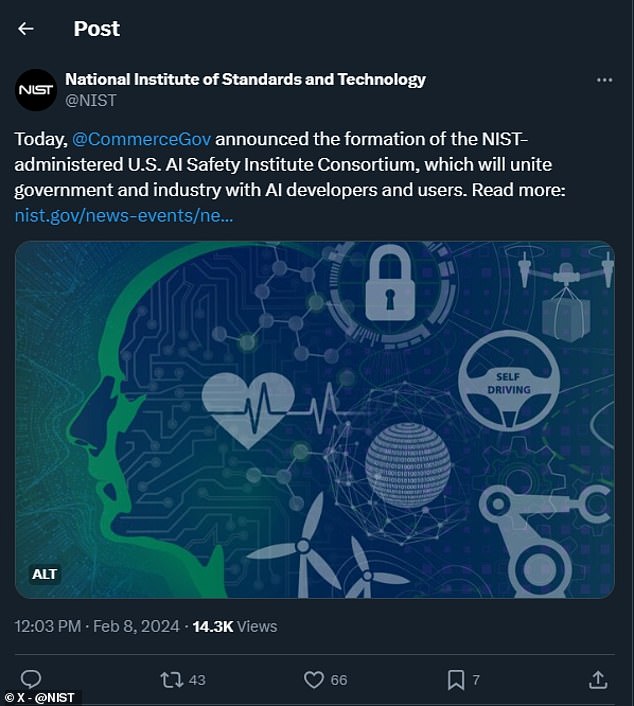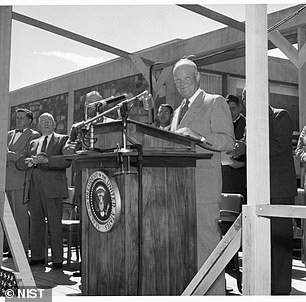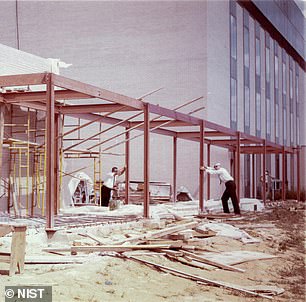Do they REALLY take AI seriously? Biden’s flagship artificial intelligence security lab appears to be riddled with black mold, vermin and a leaky roof
With only a modest $10 million budget to help regulate a billionaire industry, Biden’s new AI safety lab is now struggling alone with the safety of its own facilities.
‘Chronic underfunding’ of the National Institute of Standards and Technology (NIST), the federal laboratory that will house the new US AI Safety Institute, has led to black mold, leaking ceilings and a dead technician crushed by a concrete slab, say reports.
Despite calls from scientists and entrepreneurs who have described “the risk of AI extinction” as comparable to “pandemics and nuclear war,” GOP deficit hawks in Congress pushed for a 10 percent budget cut for NIST — and Biden approved that.
A former senior NIST official reported seeing “Home Depot dehumidifiers or portable AC units” everywhere that had been purchased by staff to help dry and slow the mold.
Another reported incessant indoor leaks during rainy weather, forcing staff to ‘cover’ critical electronic equipment.
Pests and wildlife, including snakes, have also infiltrated NIST campuses, further compromising the laboratory’s ability to conduct accurate experiments essential to their work developing official regulatory standards.
With only a modest $10 million budget to help regulate an industry of billionaires, Biden’s new AI safety lab now struggles alone with the safety of its own facilities — black mold, leaky ceilings and a dead technician crushed by a concrete slab , according to internal reports
“You see dust everywhere because the windows don’t close properly,” NIST’s former acting director Kent Rochford told me the Washington Post.
‘You see a bucket collecting drops from a leak in the roof.’
Rochford — one of more than a dozen current and former NIST employees, government officials and AI experts who spoke to the Post for their research — said he once asked for money for diving equipment to combat damage from flooding at a NIST facility.
Funding was denied, he said, but NIST was given squeegees to clean up the water.
Nearly two-thirds (more than 60 percent) of NIST’s buildings do not meet federal safety standards, according to a report commissioned by Congress last year and conducted by the National Academies of Sciences, Engineering and Medicine.
Based on the academy’s calculations, they said that “the poor and deteriorating physical condition and functionality of NIST’s facilities” absorbed 40 percent of labor productivity as staff focused on “solutions and do-it-yourself repairs.”

Elham Tabassi, NIST’s chief AI adviser, has complained that President Biden’s November executive order mandating the creation of NIST’s AI Institute created a “nearly impossible deadline.”


Both of NIST’s main campuses, in Boulder, Colorado (left) and Gaithersburg, Maryland (right), are more than half a century old, with their foundations built during the Eisenhower and Kennedy administrations, respectively.
“Pests and wildlife have at times infiltrated campuses,” the Post said, “including one incident in which a garter snake entered a Boulder building.”
James Fekete, former chief of NIST’s applied chemicals and materials division, said, “If we knew rain was coming, we would cover the microscope… It leaked enough that we were prepared.”
Sometimes these bad conditions were fatal. On September 26, 2022, to give an example which prompted a federal investigationan engineering technician was crushed by the collapse of a concrete slab at NIST’s National Fire Research Lab.
Both of NIST’s main campuses, in Boulder, Colorado and Gaithersburg, Maryland, are over half a century old, with their foundations built during the Eisenhower and Kennedy administrations, respectively.
The federal institute – charged with testing everything from the safety of industrial chemicals to the concrete used in apartment buildings to advanced biometric ID systems – has now added AI safety to its purview.
“We don’t quite know how to evaluate AI,” NIST’s chief AI advisor Elham Tabassi told a machine learning conference, NeurIPS, last December.
Tabassi complained that President Joe Biden’s November executive order mandating the creation of NIST’s AI Institute created a “nearly impossible deadline.”
“It’s a tough problem,” he said.
For the Biden White House, Commerce Department spokesman Charlie Andrews had a much rosier assessment of the situation.
“While the Administration has made clear that additional resources will be needed to fully address all of the long-term challenges AI poses,” he said, “NIST has carried out its responsibilities effectively.”
But some in the AI community are concerned that the underfunding of NIST’s AI security efforts risks giving Big Tech a chance to put its thumb on the scale.
Amazon has committed $5 million in “computing credits” to NIST’s AI efforts for their AI safety testing; and Microsoft, which owns part of ChatGPT maker OpenAI, have offered engineering teams NIST’s AI Safety Consortium.
Electrical safety problems, exactly the kind that could undermine AI safety research, have plagued NIST’s facilities, along with the mold, the leaks, the flooding, and the pests.
Researchers told the Post that they sometimes slept in their lab in an effort to monitor and secure their work during recurring blackouts.
Other staffers reported having to transport hard drives containing crucial research data between buildings due to unreliable internet connections and slow bandwidth speeds.
But according to Andrews, the Commerce Department spokesperson, NIST’s AI staff will enjoy well-equipped offices at the institute’s Gaithersburg campus, a Commerce Department office in Washington, D.C., and the NIST National Cybersecurity Center of Excellence in Rockville, Maryland.
